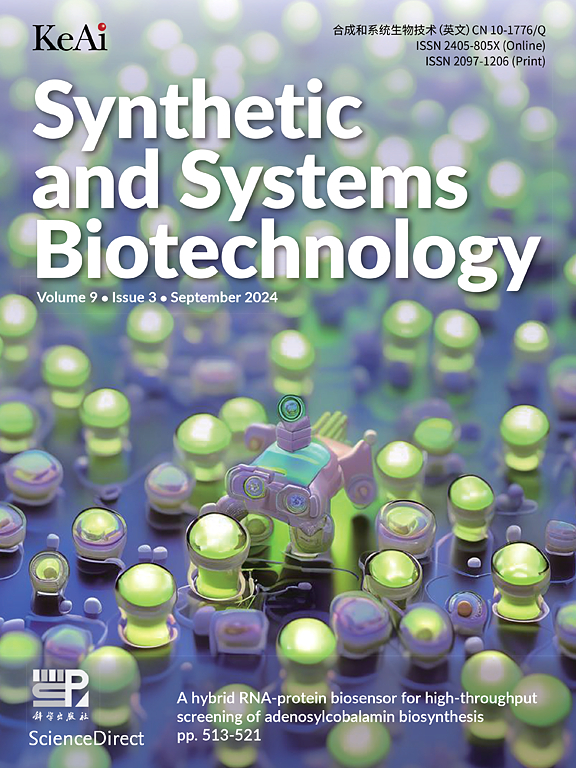优化了双aav碱基编辑器传递系统,提高了编辑效率和病毒粒子生产滴度
IF 4.4
2区 生物学
Q1 BIOTECHNOLOGY & APPLIED MICROBIOLOGY
引用次数: 0
摘要
碱基编辑器(BEs)是人类细胞和动物中精确碱基转换的一种有前途的工具,而腺相关病毒(AAV)是人类基因治疗的主要载体。然而,BE表达所需的DNA盒的大小超过了AAV载体的4.7 kb包装容量,这使得基于反式剪接的双AAV方法成为必要。即使采用这种方法,目前的分裂DNA盒仍然大于AAV包装极限,这对AAV的细胞生产提出了挑战。此外,一些分割策略产生可变的编辑结果和目标覆盖率。为了解决这些局限性,我们分别在Cas9肽上的493 - 517个氨基酸位点上测试了BE4max和A3A-BE4max的25个不同的分裂集。幸运的是,在His511和Ser512之间确定了最佳的Cas9分裂位点,并进一步操纵AAV表达盒的排列,在4.7 kb内创建均匀分布的CBE和ABE内部系统。这些新型的双aav系统,分别被命名为4.6AAV-CBE和4.7AAV-ABE,具有与野生型BEs相似的碱基编辑效率,其编辑窗口比目前的573分裂系统更窄。值得注意的是,与split-573BE系统相比,4.6AAV-CBE产生更高的AAV生产滴度,在AAV- n中高达2.1倍,在AAV- c中高达1.5倍,这可能是由于在AAV包装容量内减少了DNA盒大小。此外,以相同体积和细胞数的AAV-N和AAV-C包装感染细胞后,4.6 AAV-CBE系统的感染多重度(MOI)和编辑效率均高于split-573BE系统。本研究提出了用于ABE和CBE的先进双aav系统,为安全有效的BE治疗奠定了基础。本文章由计算机程序翻译,如有差异,请以英文原文为准。
Optimized dual-AAV base editor delivery system with enhanced editing efficiency and virion production titer
Base editors (BEs) are a promising tool for precise base conversion in human cells and animals, while the adeno-associated virus (AAV) is the major vector for human gene therapy. However, the size of the DNA cassette required for BE expression exceeds the 4.7 kb packing capacity of the AAV vector, making dual-AAV approaches based on trans-splicing intein necessary. Even with this approach, current split DNA cassettes are still larger than the AAV packing limit, posing a challenge for cellular production of AAV. Moreover, some split strategies yield variable editing results and target coverage. To address these limitations, 25 different split sets for BE4max and A3A-BE4max were tested at two target sites respectively, with splitting sites ranging from 493rd to 517th amino acids on the Cas9 peptide. Fortunately, the best Cas9 split site was identified between His511 and Ser512 and the arrangement of the AAV expression cassette was further manipulated to create evenly distributed CBE and ABE intein systems within 4.7 kb. These novel dual-AAV systems, designated 4.6AAV-CBE and 4.7AAV-ABE, were found to have base editing efficiencies similar to wild-type BEs, with a narrower editing window than the current 573 split system. Notably, 4.6AAV-CBE yield a higher AAV production titer, up to 2.1-fold in AAV-N and 1.5-fold in AAV-C, compared to the split-573BE system, likely due to the reduction of DNA cassette size within the AAV packaging capacity. Moreover, after packaging and infecting cells with AAV-N and AAV-C at the same volume and number of cells, the multiplicities of infection (MOI) and editing efficiency of 4.6 AAV-CBE were both higher than those of the split-573BE system. This study present advanced dual-AAV systems for ABE and CBE delivery, establishing a basis for safe and efficient BE therapies.
求助全文
通过发布文献求助,成功后即可免费获取论文全文。
去求助
来源期刊

Synthetic and Systems Biotechnology
BIOTECHNOLOGY & APPLIED MICROBIOLOGY-
CiteScore
6.90
自引率
12.50%
发文量
90
审稿时长
67 days
期刊介绍:
Synthetic and Systems Biotechnology aims to promote the communication of original research in synthetic and systems biology, with strong emphasis on applications towards biotechnology. This journal is a quarterly peer-reviewed journal led by Editor-in-Chief Lixin Zhang. The journal publishes high-quality research; focusing on integrative approaches to enable the understanding and design of biological systems, and research to develop the application of systems and synthetic biology to natural systems. This journal will publish Articles, Short notes, Methods, Mini Reviews, Commentary and Conference reviews.
 求助内容:
求助内容: 应助结果提醒方式:
应助结果提醒方式:


